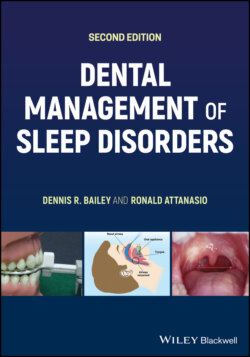Читать книгу Dental Management of Sleep Disorders - Ronald Attanasio - Страница 24
References
Оглавление1 1 Kryger, M.H., Roth, T., and Dement, W.C. (2005). Normal human sleep: an overview. In: Principles and Practice of Sleep Medicine, 13. Elsevier Saunders.
2 2 Lee‐Chiong, T.L. (2006). SLEEP: A Comprehensive Handbook, 1e. Wiley‐Liss/Wiley.
3 3 Ekirch, A.R. (2005). At Day's Close: Night in Times Past. W. W. Norton: New York.
4 4 Reiss, B. (2017). Wild Nights How Taming Sleep Created Our Restless World. New York: Basic Books.
5 5 Frérot, M., Lefebvre, A., Aho, S. et al. (2018). What is epidemiology? Changing definitions of epidemiology 1978‐2017. PloS ONE 13 (12): e0208442.
6 6 Macmahon, B. and Pugh, T.F. (1970). Epidemiology: Principles & Methods. Boston: Little, Brown and Co.
7 7 Kryger, M.H., Roth, T., and Dement, W.C. (2017). Epidemiology of sleep disorders. In: Principles and Practice of Sleep Medicine, 627. Elsevier Saunders.
8 8 American Academy of Sleep Medicine (ICSD3) (2014). The International Classification of Sleep Disorders, 3e. Darien, IL: American Academy of Sleep Medicine.
9 9 Smith, R., Ronald, J., Delaive, K. et al. (2002). What are obstructive sleep apnea patients being treated for prior to this diagnosis? Chest 121 (7): 164–172.
10 10 Young, T., Palta, M., Dempsey, J. et al. (1993). The occurrence of sleep‐disordered breathing among middle‐aged adults. N. Engl. J. Med. 328 (17): 1230–1235.
11 11 Peppard, P.E., Young, T., Barnet, J.H. et al. (2013). Increased prevalence of sleep‐disordered breathing in adults. Am. J. Epidemiol. 177 (9): 1006–1014.
12 12 American Academy of Sleep Medicine (2016). In an Age of Constant Activity, the Solution to Improving the Nation’s Health May Lie in Helping it Sleep Better. Darien, IL: Frost & Sullivan.
13 13 Benjafield, A.V., Ayas, N.T., Eastwood, P.R. et al. (2019). Estimation of the global prevalence and burden of obstructive sleep apnoea: a literature‐based analysis. Lancet Respir. Med. 7: 687–698.
14 14 Morin, C.M., LeBlanc, M., Daley, M. et al. (2006). Epidemiology of insomnia prevalence, self‐help treatments, consultations, and determinants of help‐seeking behaviors. Sleep Med. 7: 123–130.
15 15 Ohayon, M.M. and Reynolds, C.F. 3rd. (2009). Epidemiologic and clinical relevance of insomnia diagnosis algorithms according the the DSM‐IV and International Classification of Sleep Disorders (ICSD). Sleep Med. 10: 952–960.
16 16 Garcia‐Borreguero, D., Egatz, R., Winkelmann, J., and Berger, K. (2006). Epidemiology of restless leg syndrome: the current status. Sleep Med. Rev. 10 (2): 153–167.
17 17 Ohayon, M.M., O’Hara, R., and Vitiello, M.V. (2012). Epidemiology of restless legs syndrome: a synthesis of the literature. Sleep Med. Rev. 16 (4): 283–295.
18 18 Longstreth, W.T., Koepsell, T.D., Ton, T.G. et al. (2007). The epidemiology of narcolepsy. Sleep 30 (1): 13–26.
19 19 Morse, A.M. (2019). Review narcolepsy in children and adults: a guide to improved recognition, diagnosis and management. Med. Sci. 7: 106.
20 20 Beninati, W., Harris, C., Herold, D., and Shepard, W.W. (1999). The effect of snoring and obstructive sleep apnea on sleep quality of bed partners. Mayo Clin. Proc. (74): 955–958.
21 21 Foley, D., Ancoli‐Israel, S., Britz, P., and Walsh, J. (2004). Sleep disturbances and chronic disease in older adults: results of the 2003 National Sleep Foundation Sleep in America Poll. J. Psychosom. Res. 56 (5): 497–502.
22 22 Nicholson, K., Rodrigues, R., Anderson, K.K. et al. Sleep behaviours and multimorbidity occurrence in middle‐aged and older adults: findings from the Canadian Longitudinal Study on Aging (CLSA). Sleep Med. 75: 156–162. https://doi.org/10.1016/j.sleep.2020.07.002.
23 23 Shahar, E., Whitney, C., Coralyn, W. et al. (2001). Sleep‐disordered breathing and cardiovascular disease cross‐sectional results of the Sleep Heart Health Study. Am. J. Respir. Crit. Care Med. 163: 19–25.
24 24 Al‐Delaimy, W.K., Manson, J.A.E., Willett, W.C. et al. (2002). Snoring as risk factor for type II diabetes mellitus: a prospective study. Am. J. Epidemiol. 155 (5): 387–393.
25 25 Kapur, V., Blough, D.K., Sandblom, R.E. et al. (1999). The medical cost of undiagnosed sleep apnea. Sleep 22 (6): 749–755.
26 26 Peker, Y., Hedner, J., and Bende, M. (1997). Reduced hospitalization with cardiovascular and pulmonary disease in obstructive sleep apnea patients on nasal CPAP treatment. Sleep 20 (8): 645–653.
27 27 Position Statement of the American Academy of Sleep Medicine (2000). Cost justification for diagnosis and treatment of obstructive sleep apnea. Sleep 23 (8): 1017–1018.
28 28 Ronalf, J., Delaive, K., Roos, L. et al. (1998). Obstructive sleep apnea patients use more health care resources ten years prior to diagnosis. Sleep Res. Outline 1 (1): 71–74.
29 29 Yang, E.H., Hla, K.M., McHorney, C.A. et al. (2000). Sleep apnea and quality of life. Sleep 3 (4): 535–541.
30 30 Lacasse, Y., Godbout, C., and Series, F. (2002). Health‐related quality of life in obstructive sleep apnoea. Eur. Respir. J. 19 (3): 499–503.
31 31 Parish, J.M. and Lyng, P.J. (2003). Quality of life in bed partners of patients with obstructive sleep apnea or hypopnea after treatment with continuous positive airway pressure. Chest 124 (3): 942–947.
32 32 Baum, B.J. (2007). Inadequate training in the biological sciences and medicine for dental students. An impending crisis for dentistry. JADA 138 (1): 16–26.
33 33 Glick, M. (2007). The health of the nation. Why you should care. JADA 138 (2): 144–146.
34 34 From Council on Dental Practice: The Role of Dentistry in the Treatment of Sleep Related Breathing Disorders. Adopted by the American Dental Association House of Delegates. American Dental Association Adopted 2017 (2017:269).
35 35 Evidence Brief (2017). Oral Appliances for Sleep‐Related Breathing Disorders. American Dental Association.
36 36 D0411 (2017). ADA Guide to Point of Care Diabetes Testing and Reporting. ADA Guide – Version 1, 1–6 (17 July 2017).
